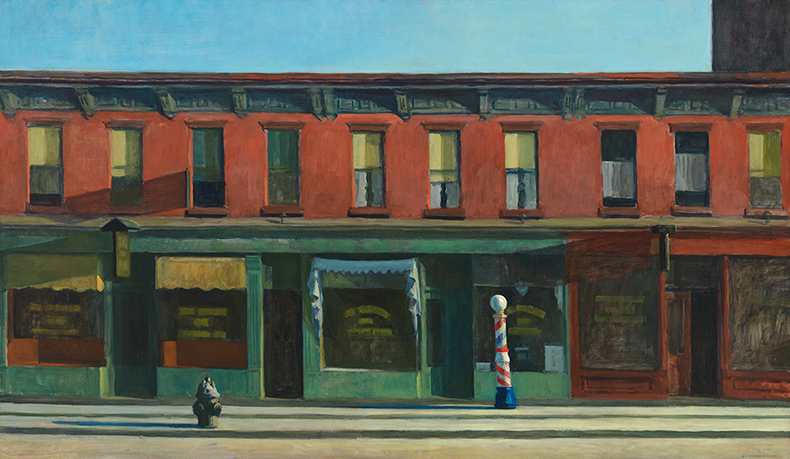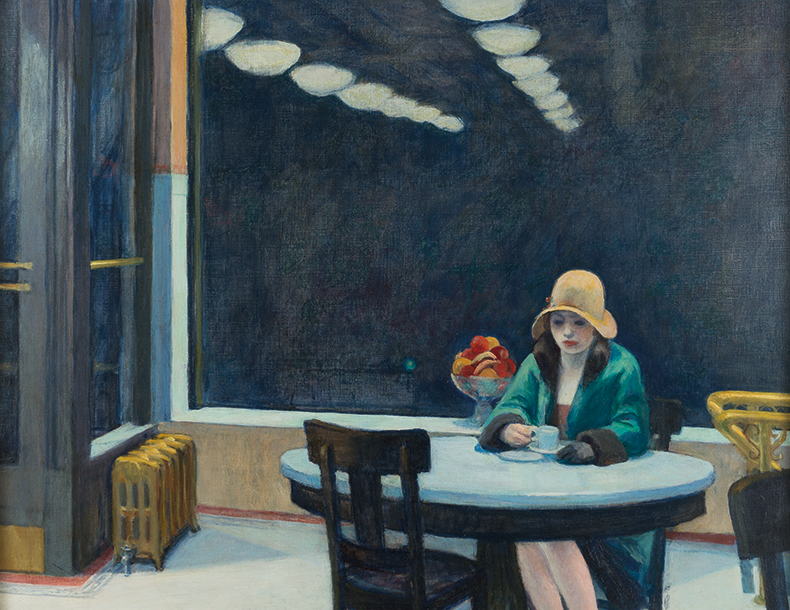From the February 2023 issue of Apollo. Preview and subscribe here.
Towards the end of the Christmas movie favourite, It’s a Wonderful Life, after George Bailey’s guardian angel has done his worst, George stumbles down Main Street, Bedford Falls, horror-struck at what has befallen the place. Bright lights advertise tawdry amusements, cheap bars and dime-a-dance nightclubs line the street. The big bad city has come for the soul of the small town. It is a nightmare vision that distils many fears about modern life. It would have resonated with many in the period – and with Edward Hopper, for sure. The truth is that while Hopper is cherished as a painter of the American city, and of New York, he didn’t much like it – didn’t like where it seemed headed, at least.
City Roofs (1932), Edward Hopper. Whitney Museum of American Art, New York. © 2022 Heirs of Josephine N. Hopper/Licensed by Artists Rights Society (ARS), NY

Born in the small town of Nyack in 1882, just across the Hudson from New York, Hopper studied in the city, then did the requisite spell in France. Upon his return, he tried to see New York as Degas saw Paris: figures shimmer across bridges, women bend and reach across tight interiors. Skyscrapers were rising: the Chrysler Building was begun in 1928 just as he was producing his best work. But he took little notice. ‘I just never cared for the vertical,’ he said. And with that he put reality aside. Hopper learned much from the Ashcan School painters of the turn of the century, yet while they captured a crowded, zesty working-class city of overhead trains and street life, Hopper’s New York is low-rise, white and middle-class, and drowsy. Early Sunday Morning (1930) is his dream vision of urban modernity: an empty street of mom-and-pop stores. Not only did he dislike the high-rise city, he couldn’t describe it, couldn’t scale it. Sometimes he doesn’t know what to do with it: when he does paint large apartment blocks, he renders them with a dreary factuality, unable to see where their drama might lie. Office in a Small City (1953) shows a pasty-faced gent sitting in a weird, white, apparently unglazed box of a building, quite severed from the streets around him. In fairness, that’s Hopper’s point: for him, the office tower was a pustule. Still, the picture is botched.
Early Sunday Morning (1930), Edward Hopper. Whitney Museum of American Art, New York. © 2022 Heirs of Josephine N. Hopper/Licensed by Artists Rights Society (ARS), NY

Clement Greenberg famously said of Hopper that, even if he were a better painter, he probably wouldn’t have been a better artist. He wasn’t wrong. For American critics today, to say so is bad form, but this transplanted Brit can say what he likes, and he is struck by the mediocrity of many of the pictures, the waxy figures, the flat and lifeless passages of paint, the rigged-up sentiment. Hopper paints water like it was Gatorade, and figures as if they belong on a Subbuteo field. What guarantees his popularity – and ensures that Hopper shows come around at the Whitney like rush-hour buses – is the iconography, the cast of types from a better America (one likely starring Tom Hanks). Hopper started life as a commercial illustrator (his nervous parents secured this concession when he headed for art school), and that training never left him. One section of the Whitney’s new show is devoted to illustrations and etchings, and it’s helpful in showing the commercial appeal of his imagery in his own time. He is resolutely figurative, though his pictures are so often depopulated that one would hardly call them anecdotal. His interest in form extends to little more than a liking for flatness, and for the queasy, organic curves of the interiors he found in cinemas and theatres.
Automat (1927), Edward Hopper. Des Moines Art Center. Photo: Rich Sanders, Des Moines, Iowa; © 2020 Heirs of Josephine N. Hopper/Licensed by Artists Rights Society (ARS), NY

Hopper has always been known as the laureate of urban solitude, of bleak American alienation. But what he describes is a classy, hard-boiled noir: the gin-joints are mean, the neon flickers, the ‘broads’ are lonely. It’s tough, but it’s a world in which a fella with a wise-crack can make his way. Automat (1927), one of Hopper’s classics, frames a pretty, melancholy woman sat before the multiplying reflections of a plate glass window. Plausibly, it might also be the viewpoint of a gent who has just come over from his table and is about to try out a line. Women like the one in Automat magnetise Hopper’s pictures; stage-left or stage-right, they are a focal centre. They look out of the pictures in fuddled pain, or inward to their own clouded souls. They invite us to do the same, and they serve as guides for how we might look at life, and at his pictures: in sobering solitude. Feeling simmers in Hopper, it rises to make the colours in his pictures burn with restrained intensity. He is an Expressionist, but of a genteel sort. The sadness he so often depicts feels surmountable. His characters need to be snapped out of their funk, with a slap on the back or a shot of bourbon. Hopper could never have imagined a world so terribly fallen that half the visitors to one of his shows would be wearing surgical masks.
In fact, Hopper’s better self has a sense of humour. He is at his best in a picture like Drug Store (1927), where the colours are rich and winey and the light of the store beckons out of the evening darkness. It describes a world the painter genuinely loves – one that makes him laugh. Here is a wonderful life in which, when George Bailey’s daughter has a cold, he can go down the street and still find Old Man Gower behind the counter, there with a remedy and a kindly word. Maybe that lonely girl from Automat is there, staring down into her soda. They advertise laxatives in the window, the ointments gather dust on shelves, but it’s good. This was America.
‘Edward Hopper’s New York’ is at the Whitney Museum of American Art, New York, until 5 March.
From the February 2023 issue of Apollo. Preview and subscribe here.



